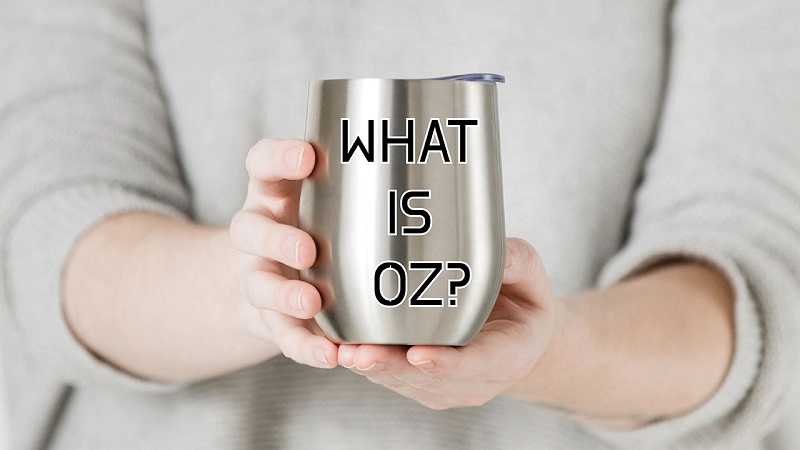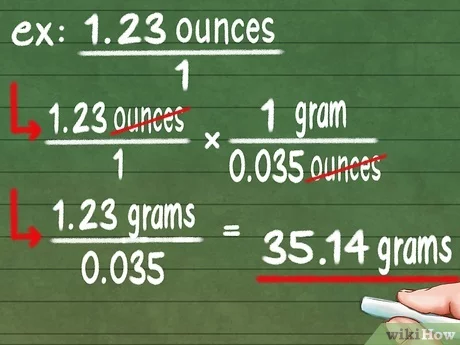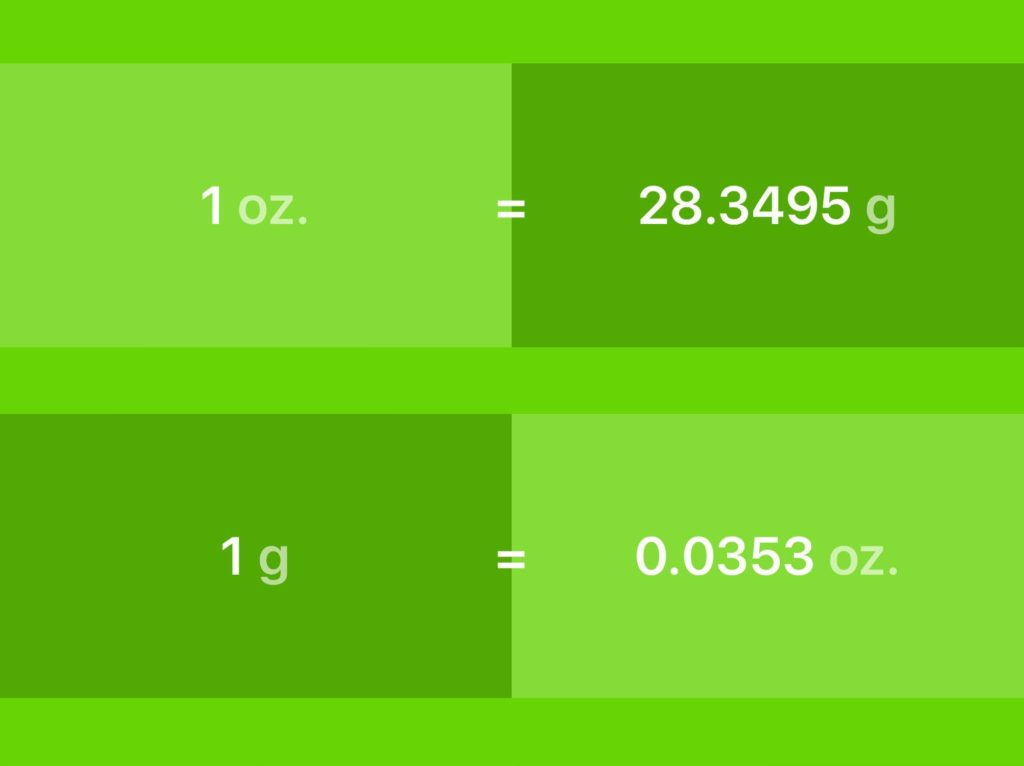How to Calculate and Convert Ounces to Grams: Check The Easiest Ways
 |
| How to convert Ounces to Gram: Best ways |
Ounces and grams are two common units used to measure weights in small quantities. Ounces commonly are used in the United States, where the main unit of measurement for weights is the pound. An ounce is 1/16 of a pound. Grams are the main base of measurement for weights in the metric system, which is used in many countries, including all of continental Europe. A simple calculation will easily convert weights in ounces to grams. This is the best ways to do it.
What is Ounce – Definition
 |
| Photo: Getty Images |
Ounce Meaning
Do you know what slice of bread, a bag of chips, a pencil, and juice have in common? They can all be measured in ounces for weight. Here, the student will learn about an ounce and its definition with conversions to other units.
It is the smallest measurement unit of weight. On packages, it is referred to by the abbreviation ‘oz’ which comes from the Italian and Spanish word onza. An ounce is almost equal to the weight of a slice of bread.
Definition of Ounce
For many years people used the unit for ounces without any standardized value. Once people understood its importance to communicate between regions efficiently, giving it a proper definition.
The definition is much easier to do within the Imperial System. Because the it is defined as 1/16 lb. Thus we can convert from lbs to kg to obtain its SI value. It is also possible to do in the other way to get ounces from kilograms.
It is 1/16 th of a pound and gram is 1/1000 th of a kilogram. Thus the definition of conversion used in the UK since 1963 and in the USA since 1959 says that one pound will be 0.45359237 kilograms exactly. This defines the ounce/gram conversion as well.
Using this definition, we get 1 ounce = 28.349523125 grams. Therefore for most of the practical purposes, we should mostly use 1ounce = 28.35g
History of Ounce
Ounce word came into English from Anglo-Norman French. There it was unce or ounce. But its abbreviation was borrowed from Medieval Italian, where the word was onza. Nowadays, the Italian word is oncia, and the area once covered by the Roman Empire has long since switched to the metric system.
Grams and ounces both are the units of measurement that associate with the concepts of mass and weight. The gram is a metric unit to measure the mass. Ounces are typically used in the United States for measuring the mass. It results from dividing a pound into the sixteen equal parts.
International avoirdupois ounce
The international avoirdupois ounce (abbreviated oz) is defined as exactly 28.349523125 g under the international yard and pound agreement of 1959, signed by the United States and countries of the Commonwealth of Nations.
In the avoirdupois system, sixteen ounces make up an avoirdupois pound, and the avoirdupois pound is defined as 7000 grains; one avoirdupois ounce is therefore equal to 437.5 grains.
The ounce is still a standard unit in the United States. In the United Kingdom it ceased to be a legal unit of measure in 2000, but is still in general usage on an informal basis and also as the indicator of portion sizes in restaurants.
International troy ounce
A troy ounce (abbreviated oz t) is equal to 480 grains. Consequently, the international troy ounce is equal to exactly 31.1034768 grams. There are 12 troy ounces in the now obsolete troy pound.
Today, the troy ounce is used only to express the mass of precious metals such as gold, platinum, palladium, rhodium or silver. Bullion coins are the most common products produced and marketed in troy ounces, but precious metal bars also exist in gram and kilogram (kg) sizes. (A kilogram bullion bar contains 32.15074657 troy ounces.)
For historical measurement of gold,
- a fine ounce is a troy ounce of pure gold content in a gold bar, computed as fineness multiplied by gross weight
- a standard ounce is a troy ounce of 22 carat gold, 91.66% pure (an 11 to 1 proportion of gold to alloy material)
What is Gram?
 |
| Photo: Study |
A gram is a unit of mass in the metric system defined as one thousandth (1 x 10-3) of a kilogram. Originally, the gram was defined as a unit equal to the mass of one cubic centimeter of pure water at 4°C (the temperature at which water has maximum density). The definition was changed when the base units for the International System of Units (SI) were redefined by the 26th General Conference of Weights and Measures. The change went into effect May 20, 2019.
The symbol for the gram is the lowercase letter "g." Incorrect symbols include "gr" (the symbol for grains), "Gm" (the symbol for the gigameter), and "gm" (easily confused with the symbol for the gram-meter, g⋅m).
Gram may also be spelled gramme.
Examples of Gram Weight
Because a gram is a small unit of weight, its size may be difficult for many people to visualize. Here are common examples of objects that have about one gram of mass:
- A small paperclip
- A thumbtack
- A piece of chewing gum
- One US bill
- A pen cap
- One cubic centimeter (milliliter) of water
- A quarter teaspoon of sugar
Useful Gram Conversion Factors
Grams may be converted into several other units of measurement. Some common conversion factors include:
- 1 gram (1 g) = 5 carats (5 ct)
- 1 gram (1 g) = 10-3 kilograms (10-3 kg)
- 1 gram (1 g) = 15.43236 grains (gr)
- 1 troy ounce (ozt) = 31.1035 g
- 1 gram = 8.98755179×1013 joules (J)
- 500 grams = 1 Jin (Chinese unit of measurement)
- 1 avoirdupois ounce (oz) = 28.3495 grams (g)
Uses of the Gram
The gram is widely used in science, particular chemistry and physics. Outside of the United States, the gram is used to measure non-liquid cooking ingredients and produce (e.g., flour, sugar, bananas). Relative composition for food nutrition labels is stated per 100 grams of product, even within the United States.
History of the Gram
In 1795, the French National Convention replaced the gravet with the gramme in the metric system. While the term changed, the definition remained that of the weight of one cubic centimeter of water. The word gramme came from the Latin word gramma which in turn derived from the Greek word grámma. The grámma was a unit used in Late Antiquity (around the 4th century AD) equal to two oboli (Greek coins) or one twenty-fourth part of an ounce.
The gram was a fundamental unit of mass in the centimeter-gram-second (CGS) system in the 19th century. The meter-kilogram-second (MKS) system of units was proposed in 1901, but the CGS and MKS systems co-exists throughout the early to mid 20th century. The MKS system became the system of base units in 1960. However, the gram was still defined based on the mass of water. In 2019, the gram was defined based on the kilogram. The kilogram has a mass almost exactly equal to that of one liter of water, but its definition has been refined, too. In 2018, Planck's constant was defined. This allowed definition of the kilogram in terms of the second and the meter. Planck's constant h is defined to be 6.62607015×10−34 and equal to one kilogram meter squared per second (kg⋅m2⋅s−1). Even so, standard masses for the kilogram still exist and are used as secondary standards for kilogram and gram weights. For all practical purposes, a liter of pure water has a mass of one kilogram and a milliliter of pure water has the mass of one gram.
Part 1: How to convert Ounces to Grams
 |
| Photo: Wikihow |
Determine the kind of ounces. In most cases, the weight is referring to the avoirdupois ounce. However, precious metals are measured in the troy ounce, which weighs slightly more than the avoirdupois ounce. Unless troy ounces are specified or the item is gold, silver or a gemstone, it is usually safe to assume the item is measured in avoirdupois ounces.
Multiply the number of ounces by 28.35 to determine the weight in grams. For a more exact calculation, multiply by 28.34952313.
Multiply the number of troy ounces by 31.1 to convert the weight in grams. For a more exact calculation, as may be required for precious metals and gemstones, multiply by 31.1034768.
To convert an ounce measurement to a gram measurement, multiply the weight by the conversion ratio.
Since one ounce is equal to 28.349523 grams, you can use this simple formula to convert:
grams = ounces × 28.349523
The weight in grams is equal to the ounces multiplied by 28.349523.
For example, here's how to convert 5 ounces to grams using the formula above.
5 oz = (5 × 28.349523) = 141.747616 g
How Many Grams are in an Ounce?
There are 28.349523 grams in an ounce, which is why we use this value in the formula above.
1 oz = 28.349523 g
Ounces and grams are both units used to measure weight.
Ounce to Gram Conversion Table
| Ounces | Grams |
|---|---|
| 1 oz | 28.35 g |
| 2 oz | 56.7 g |
| 3 oz | 85.05 g |
| 4 oz | 113.4 g |
| 5 oz | 141.75 g |
| 6 oz | 170.1 g |
| 7 oz | 198.45 g |
| 8 oz | 226.8 g |
| 9 oz | 255.15 g |
| 10 oz | 283.5 g |
| 11 oz | 311.84 g |
| 12 oz | 340.19 g |
| 13 oz | 368.54 g |
| 14 oz | 396.89 g |
| 15 oz | 425.24 g |
| 16 oz | 453.59 g |
| 17 oz | 481.94 g |
| 18 oz | 510.29 g |
| 19 oz | 538.64 g |
| 20 oz | 566.99 g |
| 21 oz | 595.34 g |
| 22 oz | 623.69 g |
| 23 oz | 652.04 g |
| 24 oz | 680.39 g |
| 25 oz | 708.74 g |
| 26 oz | 737.09 g |
| 27 oz | 765.44 g |
| 28 oz | 793.79 g |
| 29 oz | 822.14 g |
| 30 oz | 850.49 g |
| 31 oz | 878.84 g |
| 32 oz | 907.18 g |
| 33 oz | 935.53 g |
| 34 oz | 963.88 g |
| 35 oz | 992.23 g |
| 36 oz | 1,021 g |
| 37 oz | 1,049 g |
| 38 oz | 1,077 g |
| 39 oz | 1,106 g |
| 40 oz | 1,134 g |
Part 2: How to Convert Grams to Ounces
 |
| Photo: Toppr |
To convert a gram measurement to an ounce measurement, multiply the weight by the conversion ratio.
Since one gram is equal to 0.035274 ounces, you can use this simple formula to convert:
ounces = grams × 0.035274
The weight in ounces is equal to the grams multiplied by 0.035274.
For example, here's how to convert 5 grams to ounces using the formula above.
5 g = (5 × 0.035274) = 0.17637 oz
Grams and ounces are both units used to measure weight. Keep reading to learn more about each unit of measure.
Grams
A gram is the mass/weight equal to 1/1,000 of a kilogram and is roughly equivalent to the mass of one cubic centimeter of water.
The gram, or gramme, is an SI unit of weight in the metric system. Grams can be abbreviated as g; for example, 1 gram can be written as 1 g.
Ounces
One ounce is a unit of mass/weight equal to 1/16 of a pound. The common ounce should not be confused with the troy ounce, which is equal to 1/12 of a troy pound.
The ounce is a US customary and imperial unit of weight. Ounces can be abbreviated as oz; for example, 1 ounce can be written as 1 oz.
Gram to Ounce Conversion Table
| Grams | Ounces |
|---|---|
| 1 g | 0.035274 oz |
| 2 g | 0.070548 oz |
| 3 g | 0.105822 oz |
| 4 g | 0.141096 oz |
| 5 g | 0.17637 oz |
| 6 g | 0.211644 oz |
| 7 g | 0.246918 oz |
| 8 g | 0.282192 oz |
| 9 g | 0.317466 oz |
| 10 g | 0.35274 oz |
| 11 g | 0.388014 oz |
| 12 g | 0.423288 oz |
| 13 g | 0.458562 oz |
| 14 g | 0.493835 oz |
| 15 g | 0.529109 oz |
| 16 g | 0.564383 oz |
| 17 g | 0.599657 oz |
| 18 g | 0.634931 oz |
| 19 g | 0.670205 oz |
| 20 g | 0.705479 oz |
| 21 g | 0.740753 oz |
| 22 g | 0.776027 oz |
| 23 g | 0.811301 oz |
| 24 g | 0.846575 oz |
| 25 g | 0.881849 oz |
| 26 g | 0.917123 oz |
| 27 g | 0.952397 oz |
| 28 g | 0.987671 oz |
| 29 g | 1.0229 oz |
| 30 g | 1.0582 oz |
| 31 g | 1.0935 oz |
| 32 g | 1.1288 oz |
| 33 g | 1.164 oz |
| 34 g | 1.1993 oz |
| 35 g | 1.2346 oz |
| 36 g | 1.2699 oz |
| 37 g | 1.3051 oz |
| 38 g | 1.3404 oz |
| 39 g | 1.3757 oz |
| 40 g | 1.411 oz |
 How to Convert DVD to MP4: Best Methods How to Convert DVD to MP4: Best Methods Since the development of modern technology, DVDs have been a lesser choices in watching movies. Here is a detailed guide on how to convert DVD ... |
 How to Convert PDF to GIF: Best Methods How to Convert PDF to GIF: Best Methods To learn how to convert PDF to GIF in the simpliest and best ways in the article below. |
 How to Convert MOV to MP4: Simplies Ways How to Convert MOV to MP4: Simplies Ways Let's check out this guide on how to convert MOV video format to MP4 in the article below. |
 How to Convert PDF to Image Files: Best Methods and Simpliest Ways How to Convert PDF to Image Files: Best Methods and Simpliest Ways PDF and image files are two familiar format, but how do we convert from one to another? This guide will help you with it, along ... |


























